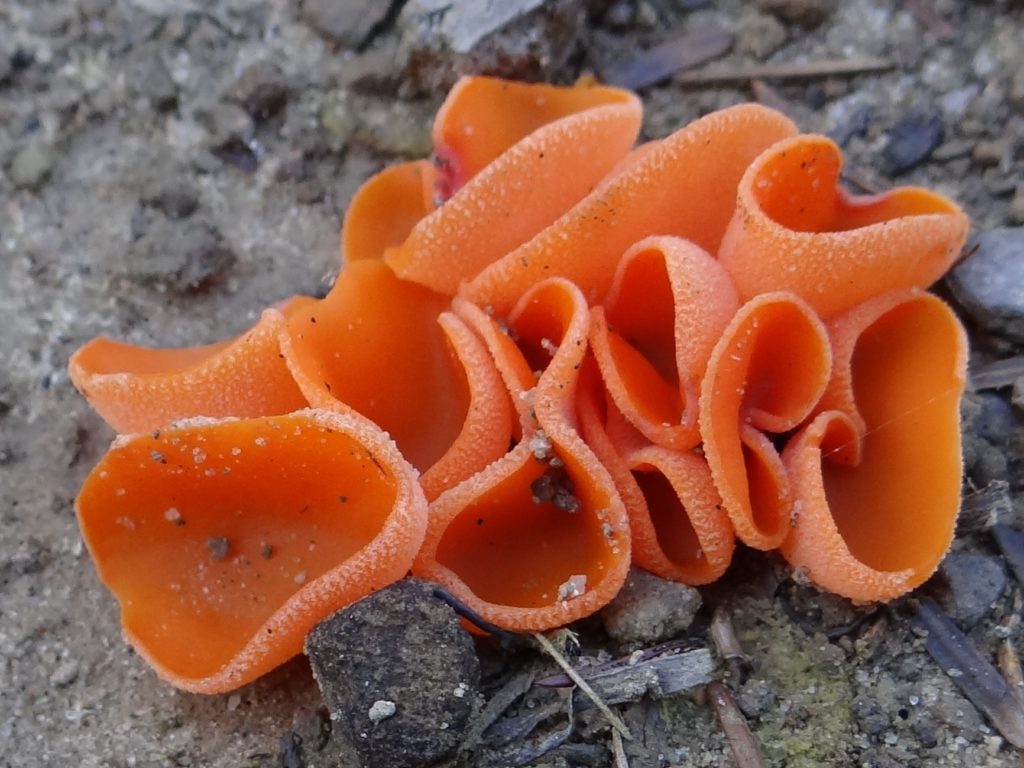Aleuria aurantia is also known as the orange peel fungus, due to its remarkable appearance. It looks like discarded orange peel on the ground. Aleuria aurantia is frequently seen flat to the ground or with a cup-like appearance, due to upturned edges. The cups are irregular in shape and may have a split or fold in on one side. Aleuria aurantia has thin and fragile sheets of orange, and they can come together looking like petals that form a rosette-like shape. Because of the cup shaping of this mushroom, it has also been referred to as the orange fairy cup fungus. It is a small to medium-sized mushroom and can grow to the size of a small orange.
Aleuria aurantia was first described in 1800 as Peziza aurantia by Christiaan Hendrik Persoon, he was a german mycologist, and the epithet aurantia is Latin for orange, due to its vibrant orange color. In 1870 the mushroom was renamed Aleuria aurantia by German botanist Karl Wilhelm Gottlieb Leopold Fuckel. In Greek Aleuria aurantia roughly translates as ‘Golden Flour’; the ‘flour’ may in reference to the whitish underside and the ‘golden’ its color.
Aleuria aurantia is considered a cup fungi as its fruiting body (ascocarp) is cup shaled. Therefore Aleuria aurantia has three specific morphological features – the upper surface, which is smooth and brightly colored orange and from here the spores are released; the lower surface which is paler and covered in a fuzziness that is lost with maturity and finally the attachment point which is a small stump of disorganized mycelium.
The Aleuria aurantia is an edible mushroom but is not considered exciting, with the exception of its color bringing alive a dish. This may be dependent on where it grows because of other foragers such that it is ‘smokey and meaty’ when fried in butter. If not eaten, it can be left to grow as an important decomposer enriching the soil with carbon, nitrogen, and hydrogen.

My name is Austin Collins.
I've dedicated my life to Mushrooms.
I believe Mushrooms are the best kept secret when it comes to health and well being.
For that reason, I would like to share a company with you that in my opinion makes the best mushroom products on the market.
The company is called Noomadic Herbals, my favorite supplement they make is called "Mushroom Total".
I take their products every day and they have helped me think better and have more energy. Give them a try.
-Austin
Aleuria Aurantia Identification and Description
Fruiting Body: No distinctive cap. Thin; brittle & fragile. Can be flat or cup shaped; may form a rosette-like structure. Grow up to 10cm diameter; can be flat to the ground or up to 5cm tall. When young the underside is fuzzy and white-grey, turning a dullish orange.
Flesh: Pale yellow or orange. Fragile.
Stem: No distinct stem; a thickening in the center of the cap attaches it to the ground.
Smell: Pleasant; mushroomy
Taste: Nondistinctive; meaty.
Spores: Big and ellipsoid with a net-like pattern, developing points at each end with maturity. Released when knocked if mushroom is fully developed; spores also released by rain drops.
Spore color: White.
Edibility: Edible.
Habitat: Saprobic. Usually grows in clusters. Like clayey ground or areas with gravel; grows on disturbed ground like trails, roadside; embankments or at the edge of woods; sometimes on woodchips. Europe; North and South America; Asia and Australasia.
Season: Country dependent Spring to Fall. In warmer climates may grow in Winter. In California peak growing season is November to January.
Scientific classification: Class: Pezizomycetes; Order: Pezizales; Family: Pyronemataceae; Genus: Aleuria and Species: Aleuria aurantia (Pers.) Fuckel.
Aleuria Aurantia Look-Alikes
Sowerbyella rhenana is similar to Aleuria aurantia, but the former is smaller and will develop a stem, unlike Aleuria aurantia. The Acervus epispartius is also similar to Aleuria aurantia as it is quite orange and does not have a stem, but there is a flap of tissue inside the cup, and it has a felty feel underneath.
Aleuria Aurantia Benefits
Edible but may offer little culinary value to a dish.
Aleuria Aurantia Dosage
There are no dosage recommendations, although, when trying any mushroom for the first time, it is always wise to eat in small doses to avoid any potential allergic reaction.
Aleuria Aurantia Toxicity, Safety & Side Effects
Aleuria aurantia is not poisonous and does not produce and toxins, but it does look a little like some Otidea mushrooms, which can be toxic; therefore, it is always wise to consult a professional mycologist if in doubt.



are these Aleuria Aurantia identical to the Orange Peziza mushrooms found in many mushroom I.D. books? they look the same.
More than likely, yes.
These are growing in abundance in a field near a roadside next to trees. I had no idea they were mushrooms, amazing. Thank you for information.